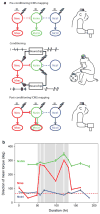New modalities of brain stimulation for stroke rehabilitation
- PMID: 23192336
- PMCID: PMC4438996
- DOI: 10.1007/s00221-012-3315-1
New modalities of brain stimulation for stroke rehabilitation
Abstract
Stroke is a leading cause of disability, and the number of stroke survivors continues to rise. Traditional neurorehabilitation strategies aimed at restoring function to weakened limbs provide only modest benefit. New brain stimulation techniques designed to augment traditional neurorehabilitation hold promise for reducing the burden of stroke-related disability. Investigators discovered that repetitive transcranial magnetic stimulation (rTMS), transcranial direct current stimulation (tDCS), and epidural cortical stimulation (ECS) can enhance neural plasticity in the motor cortex post-stroke. Improved outcomes may be obtained with activity-dependent stimulation, in which brain stimulation is contingent on neural or muscular activity during normal behavior. We review the evidence for improved motor function in stroke patients treated with rTMS, tDCS, and ECS and discuss the mediating physiological mechanisms. We compare these techniques to activity-dependent stimulation, discuss the advantages of this newer strategy for stroke rehabilitation, and suggest future applications for activity-dependent brain stimulation.
Figures



References
-
- Abraham WC. Metaplasticity: tuning synapses and networks for plasticity. Nat Rev Neurosci. 2008;9:387–399. - PubMed
-
- Ackerley SJ, Stinear CM, Barber PA, Byblow WD. Combining theta burst stimulation with training after subcortical stroke. Stroke. 2010;41:1568–1572. - PubMed
-
- Adkins DL, Campos P, Quach D, et al. Epidural cortical stimulation enhances motor function after sensorimotor cortical infarcts in rats. Exp Neurol. 2006;200:356–370. - PubMed
-
- Adkins-Muir DL, Jones TA. Cortical electrical stimulation combined with rehabilitative training: enhanced functional recovery and dendritic plasticity following focal cortical ischemia in rats. Neurol Res. 2003;25:780–788. - PubMed
Publication types
MeSH terms
Grants and funding
LinkOut - more resources
Full Text Sources
Medical

